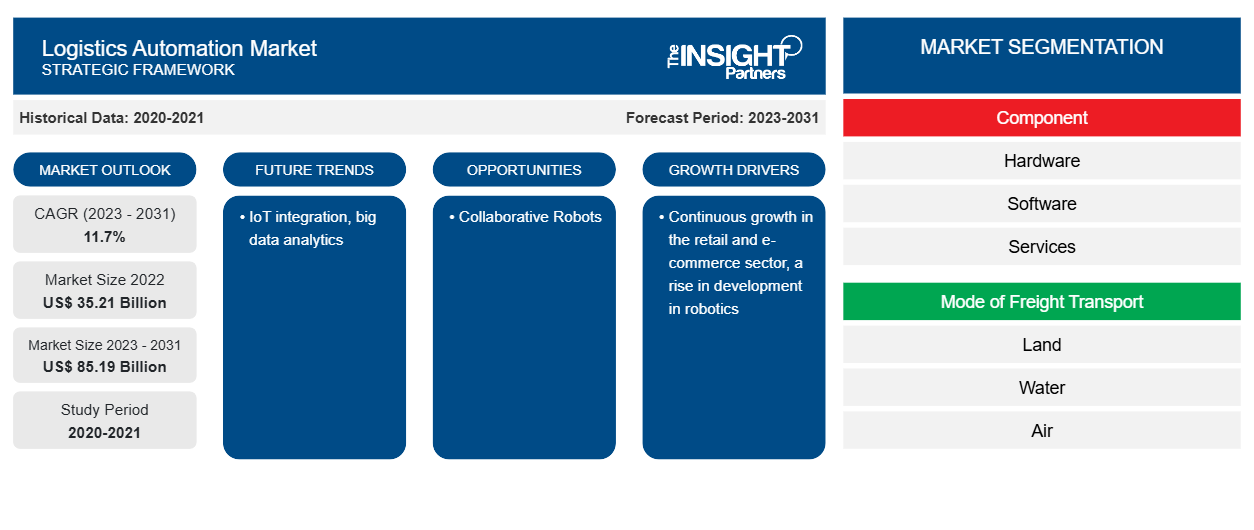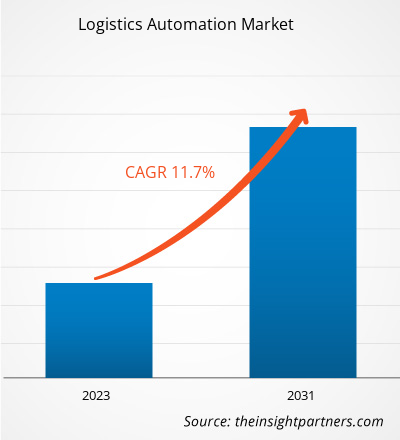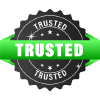The logistics automation market size is projected to reach US$ 85.19 billion by 2030 from US$ 35.21 billion in 2022. The market is expected to register a CAGR of 11.7% during 2022–2030. IoT integration and big data analytics are likely to remain a key trend in the market.
Logistics Automation Market Analysis
With the increasing consumer expectations, the market players are focusing on investing in IT and operational functions in warehouses. There is growing development in connectivity technology globally, as tech companies make everything from sortation to arranging. They are leveraging the latest supply chain technology and the Internet of Things (IoT). Smart warehouses serve as a hub to enhance the efficiency and speed of the supply chain process. From wearables on workers to sensors and smart equipment, internet-enabled devices and technology can profoundly change logistics management. Warehouse and transport management are proactively adopting logistics automation robots, which automate the storing and moving of goods across the supply chain. The logistics automation robots are integrated across warehouses and storage facilities to organize and transport products. These robots also offer enhanced levels of uptime compared to manual labor, which leads to the growth in productivity and profitability of the industry. The prime application of logistics robots is mobile automated guided vehicles (AGVs) deployed in storage facilities and warehouses for transporting goods. They operate in predefined pathways for shipping and storing the products in different pallets in the warehouses. AGVs help reduce the overall logistics cost and streamline the supply chain efficiently. Therefore, the increasing utilization of robotics in warehouses is likely to have a significant impact on the logistics automation market forecast in the next few years.
Logistics Automation Market Overview
In the logistics automation market, the importance of autonomous cars in the logistics business has grown in recent years as they have increasingly been deployed in precisely controlled environments such as warehouses and yards. However, deploying autonomous vehicles in shared and public locations, such as highways and city streets, might be the industry's next great step in optimizing logistics operations and increasing safety. The expanding technological developments in AI, as well as the increasing substantial investments in the development of sensors and visual technologies, can assist in self-driving vehicles. Autonomous vehicles and drones are important components of automated logistics systems. Google and Tesla, for example, have made substantial advances in driverless vehicle technologies. Autonomous driving has progressed from science fiction to a very feasible possibility in the last two decades, owing to significant advances in radar technology and computer power. Because portable technology has improved sufficiently to allow ultra-light hardware to make decisions based on self-improving algorithms, engineers have a better chance of mimicking human decision-making in autonomous vehicles.
Customize This Report To Suit Your Requirement
You will get customization on any report - free of charge - including parts of this report, or country-level analysis, Excel Data pack, as well as avail great offers and discounts for start-ups & universities
Logistics Automation Market: Strategic Insights

- Get Top Key Market Trends of this report.This FREE sample will include data analysis, ranging from market trends to estimates and forecasts.
You will get customization on any report - free of charge - including parts of this report, or country-level analysis, Excel Data pack, as well as avail great offers and discounts for start-ups & universities
Logistics Automation Market: Strategic Insights

- Get Top Key Market Trends of this report.This FREE sample will include data analysis, ranging from market trends to estimates and forecasts.
Logistics Automation Market Drivers and Opportunities
Continuous Growth in the Retail and E-Commerce Sector to Favor the Market
Logistics automation is one of the substantial components of e-commerce for managing the issues of inventory, tracking, packing, warehousing, and shipping. In retail and e-commerce, the business is liable for safeguarding timely delivery and return policy. If the goods or products need to be replaced, the company must handle all the operations in reverse logistics. In the retail and e-commerce business, a logistics automation provider delivers upgraded technology, scalability, flexibility, and efficiency. Additionally, the e-commerce sector is growing. For instance, India has gained 125 million online shoppers since 2020, with another 80 million expected by 2025.
The logistics requirements and services provided by the logistic automation software firms to retail and e-commerce businesses include warehouse management, supply chain management, consolidated services, and order fulfillment. There are several benefits related to e-commerce that can be fulfilled if the company outsources its logistics requirements through a logistic automation service provider. This allows the retail and e-commerce participants to perform their specific roles. Logistics automation firms specialize in supply chain management, allowing online stores to accentuate marketing and other business operations. The logistics automation software allows warehouse managers to deal efficiently with various processes such as multiline item sorting, split case picking, and palletizing. Therefore, logistics automation software has an enormous opportunity in the retail & e-commerce sector globally. This can propel the logistics automation market growth.
Collaborative Robots
Since the introduction of cobots in numerous business sectors and industry processes, the logistics and warehousing industry has experienced a boost in productivity and efficiency, allowing diverse service providers to satisfy rising demand. Cobot technology is evolving, and as Industry 4.0 emerges, supply chain efficiency and the warehousing industry will continue to benefit. Because they are constructed and engineered to collaborate with humans in any particular workspace, such as warehouses and distribution centers, cobots perform a variety of functions that help to lessen the risk of human injury. Cobots are created to perform properly and efficiently using artificial intelligence (AI) and machine learning technology.
Logistics Automation Market Report Segmentation Analysis
Key segments that contributed to the derivation of the logistics automation market analysis are components, modes of freight transport, application, and end-user industry.
- Based on component, the logistics automation market is divided into hardware, software, and services. The hardware segment held the largest share in 2022.
- By mode of freight transport, the market is segmented into land, water, and air.
- By application, the market is segmented into warehouse management and transportation management.
- By end-user industry, the market is segmented into manufacturing, retail and e-commerce, oil and gas, food and beverages, automotive, healthcare and pharmaceutical, and others.
Logistics Automation Market Share Analysis by Geography
The geographic scope of the Logistics Automation market report is mainly divided into five regions: North America, Asia Pacific, Europe, Middle East & Africa, and South & Central America.
Asia Pacific is the fastest growing region in the logistics automation market in 2022. Asia Pacific has a growing economy, which is leading to growth in a wide variety of sectors, including retail & e-commerce, manufacturing, oil & gas, food & beverages, automotive, and healthcare. The adoption of advanced and innovative technologies across the region is high. The deployment of logistics automation solutions has increased in Asian countries over time, owing to the investments and various initiatives taken by governments for the development of the retail & e-commerce industry.
The region has a strong e-commerce industry. The warehouses present in the region are implementing cutting-edge technology. Also, the growing number of products from suppliers is encouraging warehouse management to adopt robotics and logistics automation software for systematic and feasible operations. Emerging markets in Asian countries face challenges such as growing market competitiveness, cost pressures, inflation triggers, and market volatility. Thus, the planning and execution of the supply chain becomes complex. To address these issues, manufacturers and suppliers eagerly look ahead to logistics automation services to maximize the control of outbound and inbound supply chains by improving visibility and enhancing the inventory management process.
Logistics Automation Market Regional Insights
The regional trends and factors influencing the Logistics Automation Market throughout the forecast period have been thoroughly explained by the analysts at The Insight Partners. This section also discusses Logistics Automation Market segments and geography across North America, Europe, Asia Pacific, Middle East and Africa, and South and Central America.
Logistics Automation Market Report Scope
| Report Attribute | Details |
|---|---|
| Market size in 2022 | US$ 35.21 Billion |
| Market Size by 2030 | US$ 85.19 Billion |
| Global CAGR (2023 - 2031) | 11.7% |
| Historical Data | 2020-2021 |
| Forecast period | 2023-2031 |
| Segments Covered |
By Component
|
| Regions and Countries Covered | North America
|
| Market leaders and key company profiles |
Logistics Automation Market Players Density: Understanding Its Impact on Business Dynamics
The Logistics Automation Market is growing rapidly, driven by increasing end-user demand due to factors such as evolving consumer preferences, technological advancements, and greater awareness of the product's benefits. As demand rises, businesses are expanding their offerings, innovating to meet consumer needs, and capitalizing on emerging trends, which further fuels market growth.

- Get the Logistics Automation Market top key players overview
Logistics Automation Market News and Recent Developments
The logistics automation market is evaluated by gathering qualitative and quantitative data post primary and secondary research, which includes important corporate publications, association data, and databases. A few of the developments in the logistics automation market are listed below:
- OMRON announced the opening of its first automation center for logistics in Singapore to cater to the customer base of Singapore, Southeast Asia, and Oceania. (Source: OMRON, Press Release, December 2022)
- FM Logistic opened its fifth multi-customer facility (and first owned) in India. (Source: FM Logistic, Press Release, May 2022)
Logistics Automation Market Report Coverage and Deliverables
The “Logistics Automation Market Size and Forecast (2020–2030)” report provides a detailed analysis of the market covering below areas:
- Logistics automation market size and forecast at global, regional, and country levels for all the key market segments covered under the scope
- Logistics automation market trends, as well as market dynamics such as drivers, restraints, and key opportunities
- Detailed PEST/Porter’s Five Forces and SWOT analysis
- Logistics automation market analysis covering key market trends, global and regional framework, major players, regulations, and recent market developments
- Industry landscape and competition analysis covering market concentration, heat map analysis, prominent players, and recent developments for the logistics automation market
- Detailed company profiles
Frequently Asked Questions
- Historical Analysis (2 Years), Base Year, Forecast (7 Years) with CAGR
- PEST and SWOT Analysis
- Market Size Value / Volume - Global, Regional, Country
- Industry and Competitive Landscape
- Excel Dataset
Recent Reports
Related Reports
Testimonials
Reason to Buy
- Informed Decision-Making
- Understanding Market Dynamics
- Competitive Analysis
- Identifying Emerging Markets
- Customer Insights
- Market Forecasts
- Risk Mitigation
- Boosting Operational Efficiency
- Strategic Planning
- Investment Justification
- Tracking Industry Innovations
- Aligning with Regulatory Trends
Yes! We provide a free sample of the report, which includes Report Scope (Table of Contents), report structure, and selected insights to help you assess the value of the full report. Please click on the "Download Sample" button or contact us to receive your copy.
Absolutely - analyst assistance is part of the package. You can connect with our analyst post-purchase to clarify report insights, methodology or discuss how the findings apply to your business needs.
Once your order is successfully placed, you will receive a confirmation email along with your invoice.
• For published reports: You'll receive access to the report within 4-6 working hours via a secured email sent to your email.
• For upcoming reports: Your order will be recorded as a pre-booking. Our team will share the estimated release date and keep you informed of any updates. As soon as the report is published, it will be delivered to your registered email.
We offer customization options to align the report with your specific objectives. Whether you need deeper insights into a particular region, industry segment, competitor analysis, or data cut, our research team can tailor the report accordingly. Please share your requirements with us, and we'll be happy to provide a customized proposal or scope.
The report is available in either PDF format or as an Excel dataset, depending on the license you choose.
The PDF version provides the full analysis and visuals in a ready-to-read format. The Excel dataset includes all underlying data tables for easy manipulation and further analysis.
Please review the license options at checkout or contact us to confirm which formats are included with your purchase.
Our payment process is fully secure and PCI-DSS compliant.
We use trusted and encrypted payment gateways to ensure that all transactions are protected with industry-standard SSL encryption. Your payment details are never stored on our servers and are handled securely by certified third-party processors.
You can make your purchase with confidence, knowing your personal and financial information is safe with us.
Yes, we do offer special pricing for bulk purchases.
If you're interested in purchasing multiple reports, we're happy to provide a customized bundle offer or volume-based discount tailored to your needs. Please contact our sales team with the list of reports you're considering, and we’ll share a personalized quote.
Yes, absolutely.
Our team is available to help you make an informed decision. Whether you have questions about the report’s scope, methodology, customization options, or which license suits you best, we're here to assist. Please reach out to us at sales@theinsightpartners.com, and one of our representatives will get in touch promptly.
Yes, a billing invoice will be automatically generated and sent to your registered email upon successful completion of your purchase.
If you need the invoice in a specific format or require additional details (such as company name, GST, or VAT information), feel free to contact us, and we’ll be happy to assist.
Yes, certainly.
If you encounter any difficulties accessing or receiving your report, our support team is ready to assist you. Simply reach out to us via email or live chat with your order information, and we'll ensure the issue is resolved quickly so you can access your report without interruption.















The List of Companies - Logistics Automation Market
- Honeywell International Inc.
- Beumer Group
- Daifuku Co., Ltd.
- KNAPP AG
- Mecalux, S.A.
- Dematic (KION Group)
- Murata Machinery, Ltd.
- TGW Logistics Group
- Swisslog Holding AG
- VITRONIC






 Get Free Sample For
Get Free Sample For